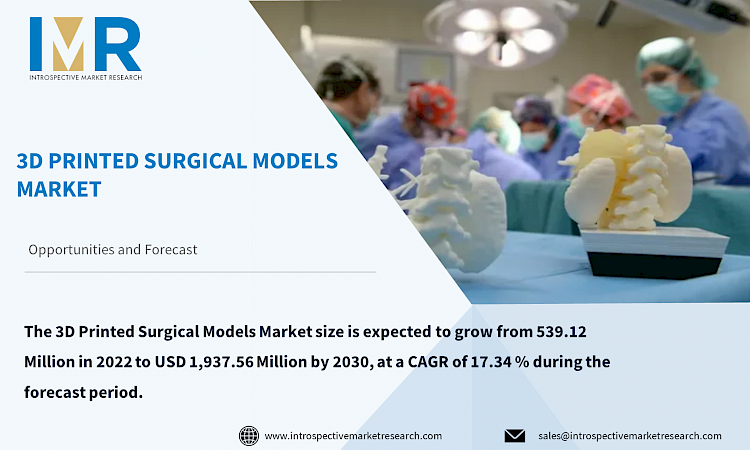Market Overview:
The 3D Printed Surgical Models Market size is expected to grow from 539.12 Million in 2022 to USD 1,937.56 Million by 2030, at a CAGR of 17.34 % during the forecast period.
An operation is typically prepared using a specific category of models called surgical models in order to achieve better results after the operation. They are also used in the planning of interventions for the management of hypoplastic left heart syndrome. By using surgical models created using 3D printing technology, young surgeons can benefit from the education offered through the tactile and three-dimensional examination of various tissues and body parts. The market statistics for 3D printed surgical models have improved as a result of their use in the healthcare sector for procedures like endovascular aneurysm repair, planning tumor resection, treating trauma injuries in orthopedic surgery, and planning tumor resection.
Top Key Players in the 3D Printed Surgical Models Market:
Stratasys Ltd(Israel), 3D Systems Inc. (United States), TeVido BioDevices (United States), Lazarus 3D (United States), Osteo3D (India), Materialise NV (Europe), Axial3D (United Kingdom), Onkos Surgical (United States), Formlabs (United States), Joimax GmbH (Germany), 3D LifePrints UK Ltd. (United Kingdom), and Other Major Players.
Market Dynamics and Factors for the 3D Printed Surgical Models Market:
Drivers:
Increasing in Chronic Diseases
The increasing prevalence of chronic diseases is driving the growth of the 3D-printed surgical models market in several ways. Chronic diseases are medical conditions that last for an extended period and often require long-term management and treatment. These conditions can include cardiovascular diseases, cancer, diabetes, respiratory diseases, and musculoskeletal disorders, among others. Chronic diseases often require personalized treatment plans tailored to each patient's unique anatomy and condition. 3D-printed surgical models offer a highly accurate and patient-specific representation of the affected area, enabling surgeons to plan and practice complex procedures before the actual surgery.
Opportunities:
Surge in Research and Development Activities
The surge in research and development (R&D) activities presents significant opportunities for the 3D-printed surgical models market. As medical technology and healthcare continue to advance, research and development efforts are accelerating to improve patient outcomes, enhance surgical procedures, and optimize medical devices. The influx of R&D investments drives innovation in 3D printing technology and materials. As researchers discover new materials and techniques, the quality and capabilities of 3D-printed surgical models improve, leading to more accurate and detailed representations of patient anatomy.
Segmentation Analysis of the 3D Printed Surgical Models Market:
By Technology, The Stereolithography (SLA) segment is driving the 3D printed surgical models’ market due to several key advantages it offers over other 3D printing technologies. Stereolithography is a widely used additive manufacturing technique that uses photopolymerization to create highly detailed and accurate 3D models.
By End User, the hospital segment is driving the 3D printed surgical models’ market due to several factors that highlight the growing adoption and benefits of these models in the healthcare industry. Hospitals play a vital role in patient care, surgical planning, and medical education, and they are increasingly recognizing the value of 3D printed surgical models.
Regional Analysis of the 3D Printed Surgical Models Market:
North America previously dominated the global market for 3D-printed surgical models, and analysts predict that this trend will continue into the foreseeable future. A growing elderly population and the presence of major industry players in the area would be two factors driving the global market for 3D-printed surgical models during the forecast period.
Key Industry Development:
In November 2021, Axial3D started working with Fast Radius, Inc., a digital manufacturing and supply chain company, helping physicians visualize patient anatomy to produce intricate surgical models. Leveraging Fast Radius' Cloud Manufacturing Platform, Axial3D is creating customized 3D-printed models to improve surgical planning and patient outcomes.
In August 2021, the company's Mimics Enlight cardiovascular planning software suite will include new Left Atrium Appendage Occlusion (LAAO) procedure support technologies 2021, boosting Materialize 3D printing capabilities in the field of cardiology
For this report, Introspective Market Research has segmented the 3D Printed Surgical Models Market based on region:
Regional Outlook (Revenue in USD Million; Volume in Units, 2023-2030)
North America
- US
- Canada
- Mexico
Eastern Europe
- Bulgaria
- The Czech Republic
- Hungary
- Poland
- Romania
- Rest of Eastern Europe
Western Europe
- Germany
- UK
- France
- Netherlands
- Italy
- Russia
- Spain
- Rest of Western Europe
Asia Pacific
- China
- India
- Japan
- South Korea
- Malaysia
- Thailand
- Vietnam
- The Philippines
- Australia
- New Zealand
- Rest of APAC
Middle East & Africa
- Turkey
- Bahrain
- Kuwait
- Saudi Arabia
- Qatar
- UAE
- Israel
- South Africa
South America
- Brazil
- Argentina
- Rest of SA





